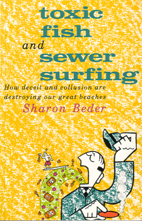
by Sharon Beder
first published by Allen & Unwin, Sydney, 1989
Introduction
Sewers seaward
Toothless watchdog
Toxic fish
Sewer-side surfing
Public relations battle
Events of 1989
Beyond Sydney
Conclusion
Bibliography
THE DEBATES over the extended ocean outfalls were essentially arguments over predictions and interpretations of findings – arguments that reflected differing value systems and priorities. On one side was the Water Board, a big and powerful organisation with vast amounts of public relations money and concerned firstly with its own image and power. It was hesitantly backed up by a slightly suspicious SPCC, somewhat beholden to the Board for taking the industrial waste into the sewers so that the rivers could be cleaned up. Also lending support were a bevy of government politicians who didn’t want to know the details as long as the experts had it all under control and service rates were kept low.
On the other side were the surfers and swimmers who intuitively felt that ocean disposal was disgusting and the deepwater outfalls wouldn’t work. They were represented by a few small, unfunded, under-resourced but determined groups like STOP and POOO. Also there were the environmentalists, overworked and underpaid, confronting hundreds of issues that needed attention. They wanted to see the sewage used as fertiliser and the water in the sewage reused, but such proposals were expensive and economics always seemed to get priority over the environment. There were politicians on this side too – the politicians in opposition who took advantage of the unexpressed discontent just below the surface. But most of the early opposition to the extended ocean outfalls came from people who were philosophically opposed to the idea of ocean disposal because they felt it wasted resources. These people were not converted by facts and figures about how well the outfalls would work. When the Environmental Impact Statements for Sydney’s extended ocean outfalls were displayed in 1980 many submissions referred to the outfalls as a ‘short-sighted solution’ or a ‘stop-gap measure’. They called for the return of sewage to the land, utilisation of the sewage as fertiliser for urban tree plantations or crop production further west, and reuse of the water.
The main argument used by the Board against reuse and sewage farming was cost. But the cost estimates made by the Board’s consultants were never detailed. The costing included treating all the sewage from the three major outfalls with secondary treatment, piping it westward across the dividing range and then putting it into a river – a very different scheme from the ones suggested by those advocating reuse.
At first the Water Board treated with contempt the calls for sewage utilisation and water recycling that filled the papers at the time. In an official response to the Total Environment Centre the Board chairman claimed that ‘any qualified person’ could see that land treatment of sewage was ‘only superficially attractive’ and, far from acceptable, was not viable. ‘The environment centre apparently wants these exhaustively-researched impact studies cast aside in favour of a scheme which is totally inappropriate to the Sydney region . . . Is the board to abandon the coastal treatment plants, which have already cost more than $ 100 million . . . ?’ (Southern News, 15/4/80). In other words, the Board wasn’t going to waste all the money it had already committed to ocean disposal. The proposed outfalls would reinforce that commitment.